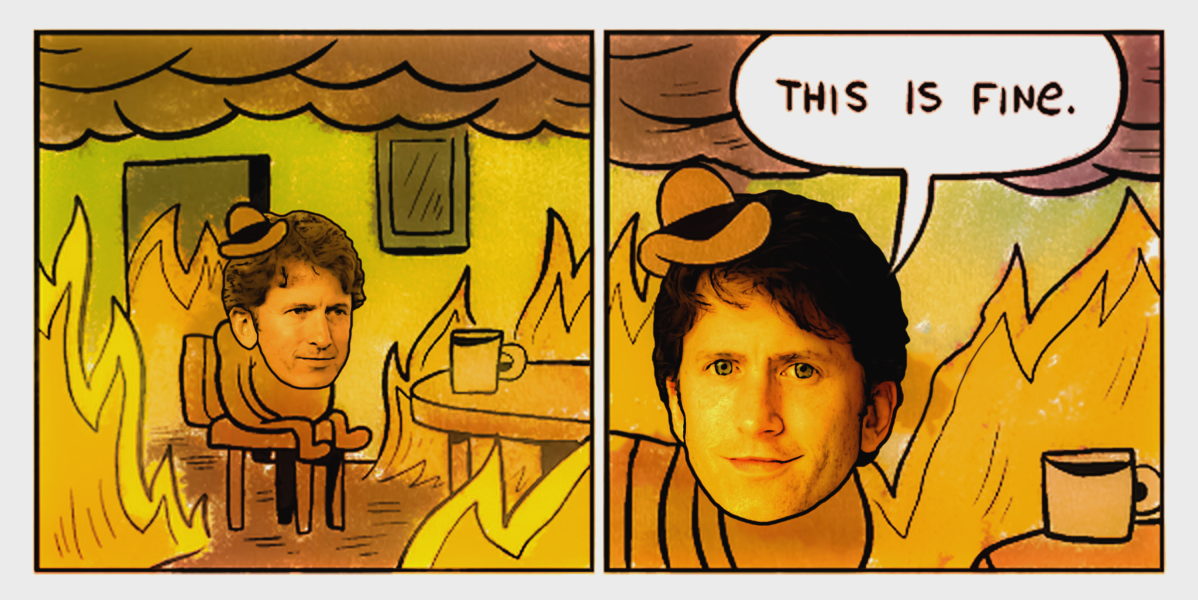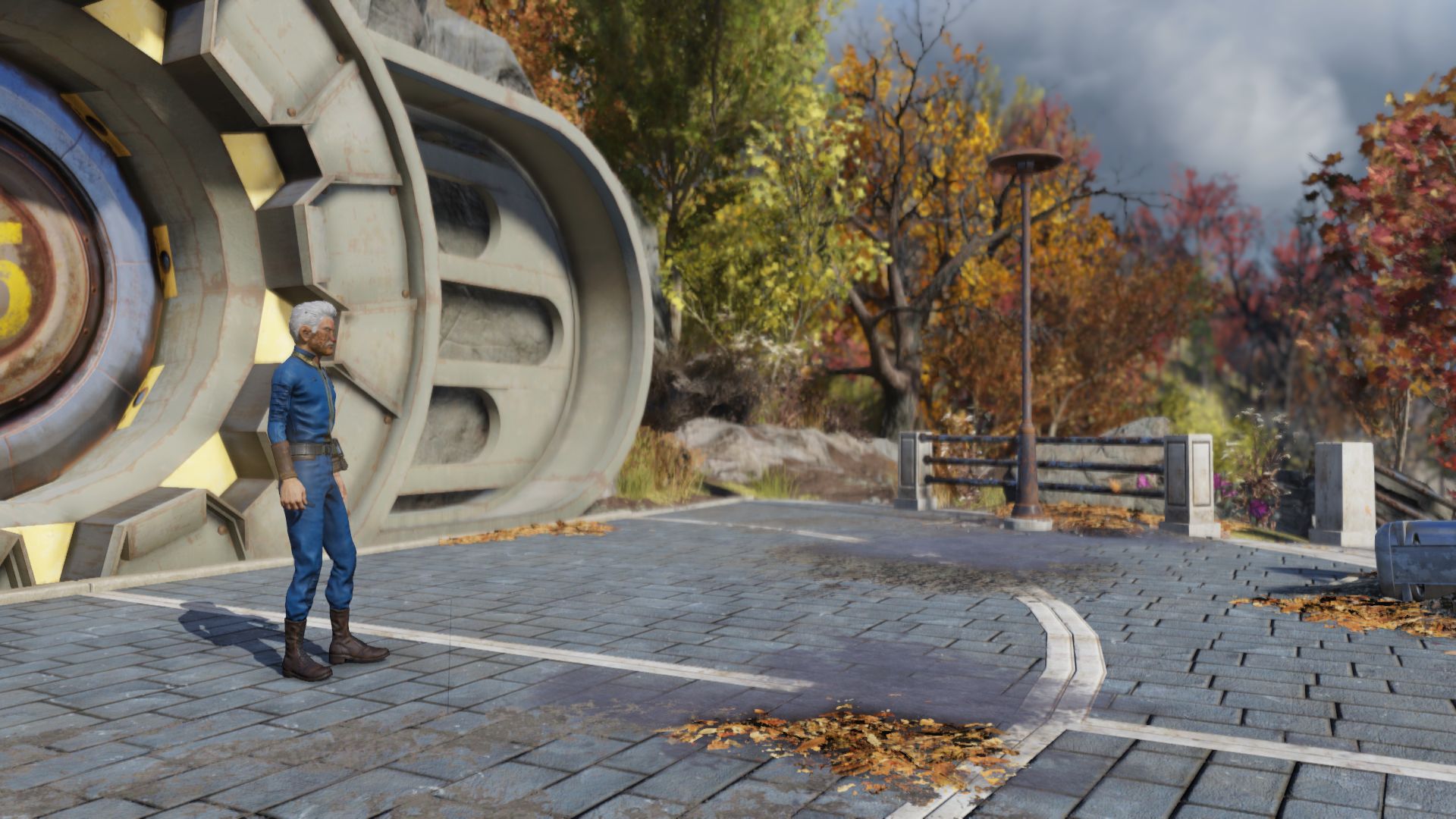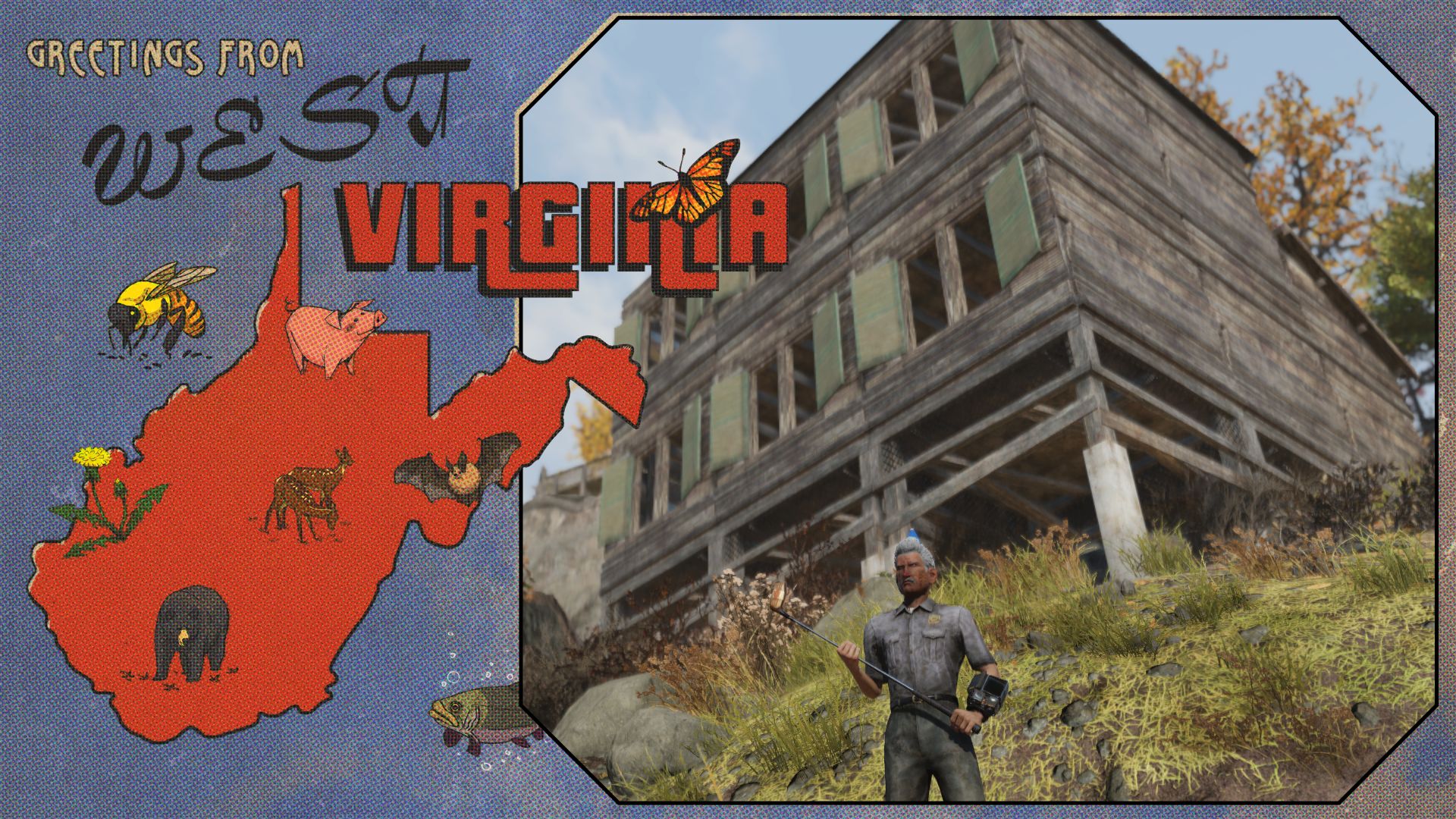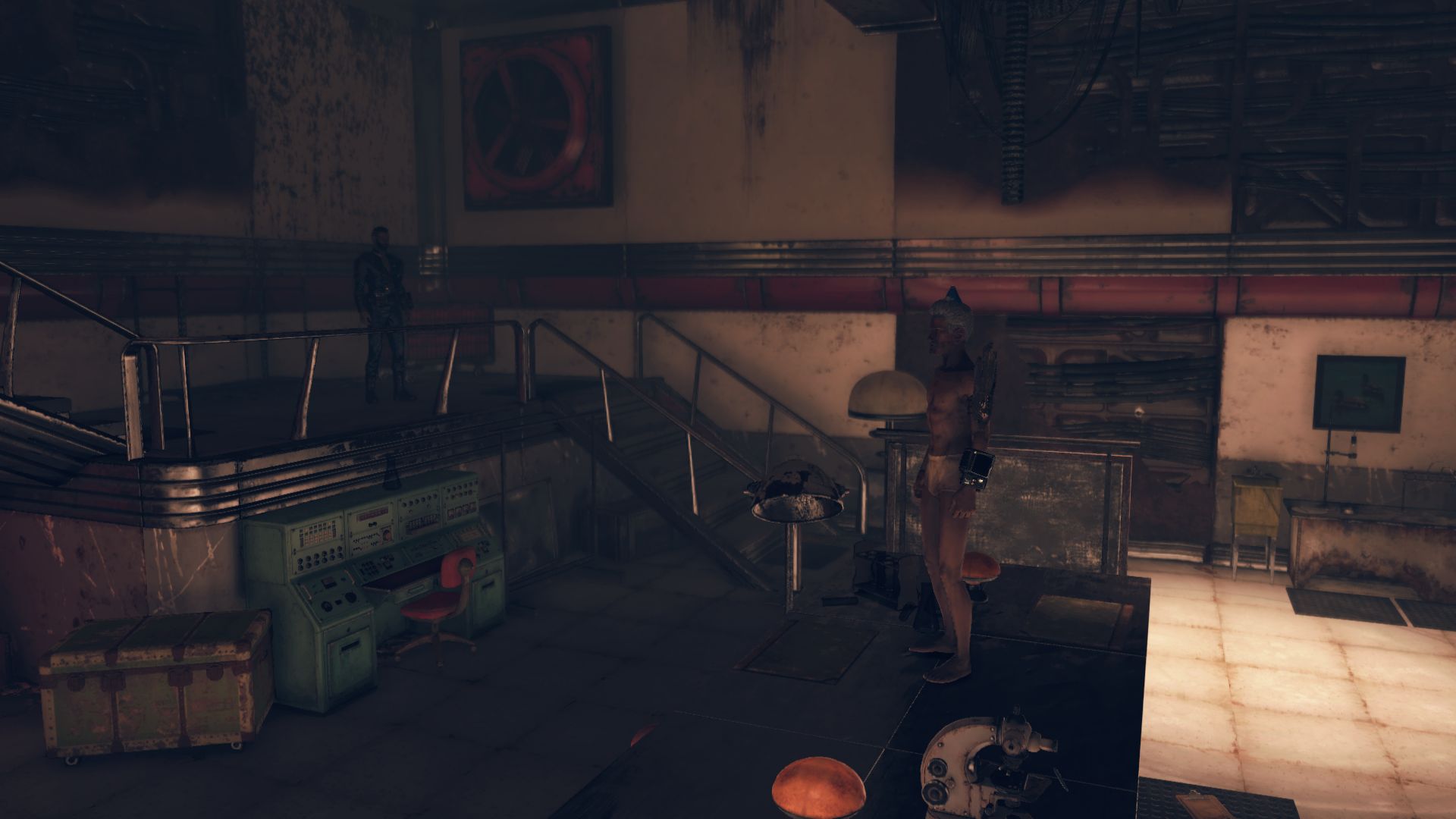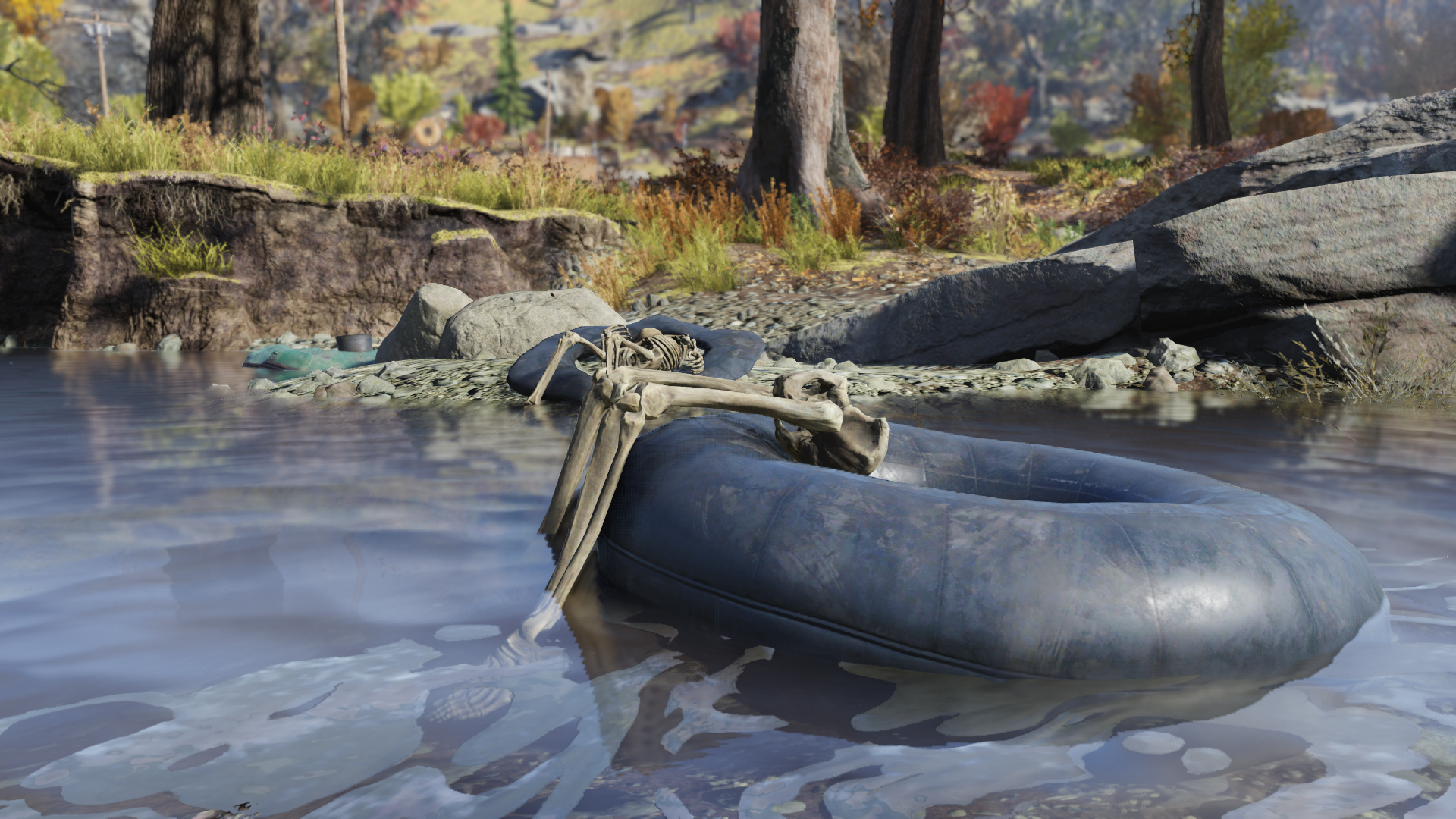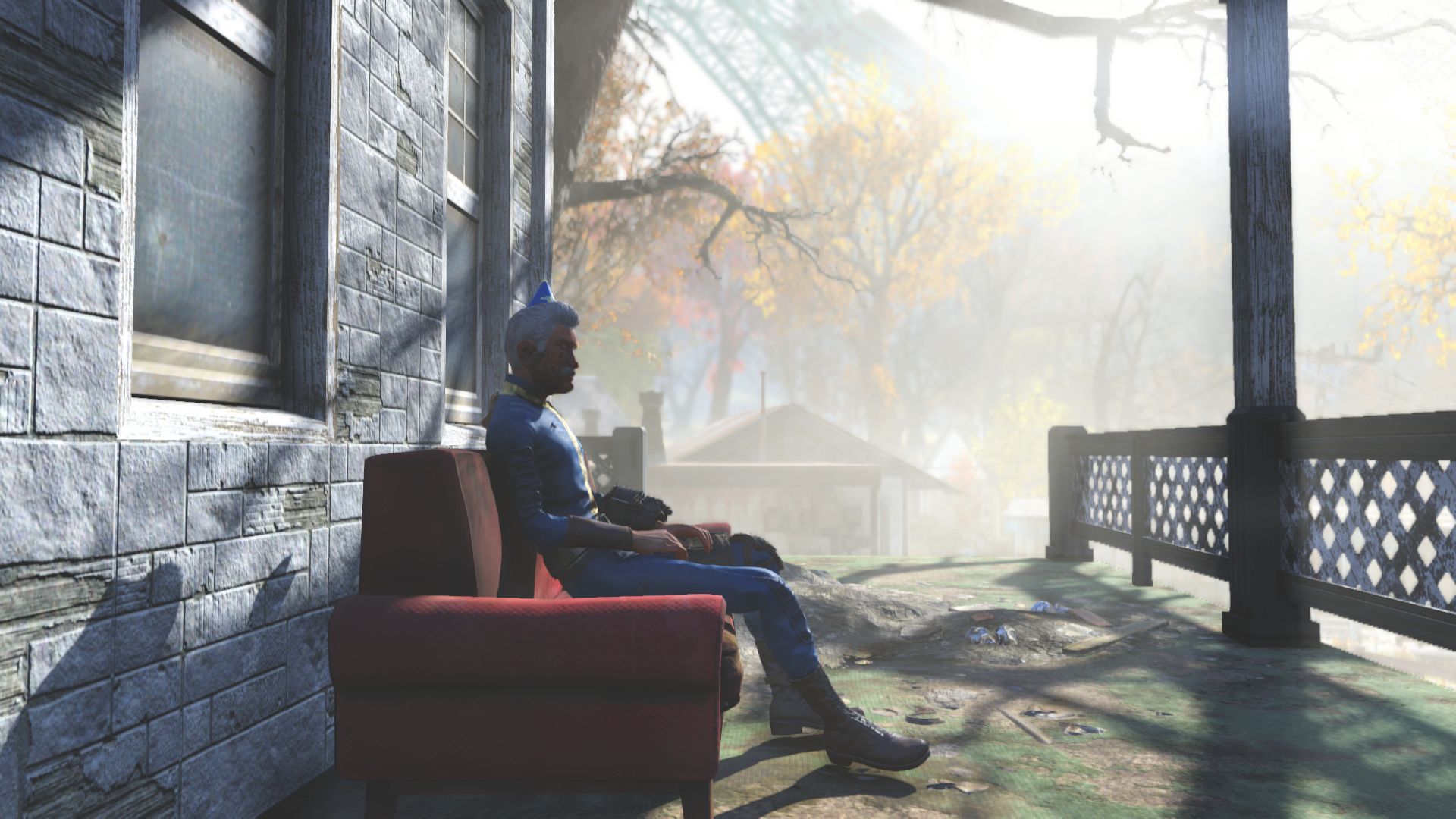-
Welcome to rpgcodex.net, a site dedicated to discussing computer based role-playing games in a free and open fashion. We're less strict than other forums, but please refer to the rules.
"This message is awaiting moderator approval": All new users must pass through our moderation queue before they will be able to post normally. Until your account has "passed" your posts will only be visible to yourself (and moderators) until they are approved. Give us a week to get around to approving / deleting / ignoring your mundane opinion on crap before hassling us about it. Once you have passed the moderation period (think of it as a test), you will be able to post normally, just like all the other retards.
You are using an out of date browser. It may not display this or other websites correctly.
You should upgrade or use an alternative browser.
You should upgrade or use an alternative browser.
Fallout 76 - online Fallout spinoff from Bethesda - now on Steam with Wastelanders NPC expansion
- Thread starter frajaq
- Start date
Never ceased to be amazed about how many people are still obsessed with this low-talent studio low-quality products. My only explanation is that for the last 30 years they have been basically the only game in town - the only ones making big budget, open-world, single-player RPGs in the most popular, most coveted setting: high-fantasy. There has never been any competition for that.
There are a lot of big budget, open-world, high-fantasy MMOs. A lot of big budget, open-world non-RPGs (Ubisoft). Some big budget, high-fantasy RPGs but not open-world (Bioware). Some high-fantasy, open-world RPGs but not triple A (Piranha Bytes). The closest competitor is Witcher 3 (twenty years after Arena) but it's a bit too mature and low-fantasy for your typical fantasy fans. People are so starved for open-world RPGs even a manchild-hostile, zero-fantasy game like Kingdom Come can sell a million copies in a week. But NOBODY FUCKING NOTICES THAT?
What if Blizzard decided to make a single-player, open-world RPG in the Warcraft world? Can you imagine the craze if Ubisoft made an open-world, single-player RPG in the LotR setting? Or the Forgotten Realms setting? Or the fucking GoT or Conan setting? Or the world of R. E. Feist, Robert Jordan, Terry Brooks, Terry Goodkind or other insanely popular epic-fantasy worlds? How utterly obvious Bethesda's ineptitude, incompetence and laziness would then become?
How is it nobody is willing to collect those hundreds of millions in sales that literally pile in huge drifts all over the place?
There are a lot of big budget, open-world, high-fantasy MMOs. A lot of big budget, open-world non-RPGs (Ubisoft). Some big budget, high-fantasy RPGs but not open-world (Bioware). Some high-fantasy, open-world RPGs but not triple A (Piranha Bytes). The closest competitor is Witcher 3 (twenty years after Arena) but it's a bit too mature and low-fantasy for your typical fantasy fans. People are so starved for open-world RPGs even a manchild-hostile, zero-fantasy game like Kingdom Come can sell a million copies in a week. But NOBODY FUCKING NOTICES THAT?
What if Blizzard decided to make a single-player, open-world RPG in the Warcraft world? Can you imagine the craze if Ubisoft made an open-world, single-player RPG in the LotR setting? Or the Forgotten Realms setting? Or the fucking GoT or Conan setting? Or the world of R. E. Feist, Robert Jordan, Terry Brooks, Terry Goodkind or other insanely popular epic-fantasy worlds? How utterly obvious Bethesda's ineptitude, incompetence and laziness would then become?
How is it nobody is willing to collect those hundreds of millions in sales that literally pile in huge drifts all over the place?
How is it nobody is willing to collect those hundreds of millions in sales that literally pile in huge drifts all over the place?
They're not on the lookout for unfilled niches. Their hands are firmly wrapped around their little dinky-doo-diddlies while they drool over the profits being made in niches that have already been filled, and that have become popular (and thus no longer niche). Their only thought is the hope to copy what everyone else is doing well enough to get a piece of the action.
The risk aversion of nearly all modern AAA developers and publishers—keeping in mind that the businessmen who control the purse strings make most of the important calls, and not Joe Blow game dev—is absolutely total. This fact, combined with a widespread lack of genuine creative talent (outside of art and sound) and even programming talent, also means that they're often loathe to branch out from the types of games they've been making for the past decade.
In my ideal world, these hollow people will end up homeless. Talentless hacks are actually worse than homeless people. You'd probably buy a meal for a guy terminally down on his luck, but would you buy a meal for one of the useless faggots in modern game development?
Wunderbar
Arcane
- Joined
- Nov 15, 2015
- Messages
- 8,825
who do you take me for, i didn't watch that.Hahahaha why did you watch it? He is known for being pseudo-intellectual retard that likes to spew pretentious drivel for ours.
The risk aversion of nearly all modern AAA developers and publishers is absolutely total
Sure, that's obvious. But making an open-world RPG in the LotR or Conan world is probably the least risky proposition in the entire business. The only reason they won't do it isn't risk-aversity but their obsession with MTX. They see Blizzard making all this dough for relatively low-effort, low-cost games like Overwatch or Hearthstone and they all want THAT. They're not interested in investing 100+ million in an open-world RPG and making 300 million. They'd much rather invest 150k in a cheap dumb card game and make a billion. That's why Artifact happened.
My only hope is thanks to Artifact, F76, Battlefront II and other flops the MTX based model is finally imploding and everyone will soon get back to making real games instead of thinly disguised slot machines.
Last edited:
moon knight
Matt7895's alt
This is what 76 should've been
Razor
Arcane
- Joined
- Sep 22, 2014
- Messages
- 942
So, thus far I have gathered that the Austin branch is primarily responsible for F 76% off. ID, Arkane etc were most likely bought in as reinforcements in the development pipeline. Wonder what the internal corporate climate is right now. Zenimax overlords rolling out the guillotine "cost saving measures and structural reforms" for the heavy PR damage? Sure, they probably rolled bank right now but the decline of Bethesda fanboy goodwill is gonna reflect in sales numbers for the next release.
Bliblablubb
Arcane
He probably needs to accept the challenge first and turn his back on you.in f4 you could shoot someone in powerarmor in the back in power core, destroying it and forcing out of shell. Can it be done to troll people in f76? I know that dmg is minimal if you engage but I wonder if you can still troll people out of armor and run
Does F76's VATS even have the ability to target individual parts? All the videos I have seen showed just a basic aimbot.
Heh, even IF it was possible, it would probably work as reliable as in FO4 (having just copied the script again).
I remember a named raider in FO4 with a fatman at "Outpost Zumanji" or smth giving me trouble. So I used a crit make the best out of the 1% hitchance for the core, must have been a black hole there for the bullet to make a 180° turn.
The raider just casually stepped out of the power armor while it exploded, unharmed, because... reasons. Then he stepped back into it, since cores are for amateurs, charged at me, shoved his nuke up my nose at point blank range and walked away. Unharmed.
Using Preston Gravy to catch the nukes worked better.
I never checked it, but I have the nagging suspicion that the pre-placed fatman raiders had some kind of explosion immunity, since the AI had the tendency to shoot walls with it.
Radiant AI. It just works.
Last edited:
- Joined
- Jan 28, 2011
- Messages
- 100,855















New adventures in discovering what the RPG Codex has been saying for years:
Experienced Points: Taking Out Bethesda’s Trash Bag
My column this week details the mind-boggling string of outrageous failures perpetrated by Bethesda surrounding the Power Armor edition of Fallout 76. Specifically, it talks about how this $200 edition of the game promised a canvas bag but delivered something worth far less.
Like I say in the article, a company as big as Bethesda has no excuse whatsoever for making this kind of mistake. Only an idiot would cut this particular corner. If you’ve got a customer willing to pay you $200 for a videogame with some extra trinkets, then you need to make sure that customer is happy. Not because you’re a nice person or you care about the customer, but because this customer is a cash cow and treating them well will allow you to extract more wealth from them in the future. I’m not faulting Bethesda for being rapacious and exploitative, I’m faulting them for attempting to be rapacious and exploitative and being completely shit at it.
It’s easy to look at Fallout 76 and see that Bethesda is arriving two years late to the fad of Day Z clones. Fine. They attempted to jump on a trend and they miscalculated. Predicting the future is hard and I don’t fault them for messing up. But the canvas bag controversy? Market segmentation is Business 101. This is the easy stuff. The obvious stuff. If you can’t get this right then what are you doing trying to run a company?
We can compare this to Valve. Recently they entered the collectible card game market with Artifact. It’s a game where the developer allows you to spend real money for a chance to win virtual goods that cost nothing to produce. Not only is the customer spending actual money for imaginary goods, but they aren’t even guaranteed to get the goods they want! And instead of feeling ripped off, that just gives them a reason to pay the developer even more money for another spin with the random number generator.
I can understand why a company would want to run a CCG. There’s a lot of money in it. We can call it cynical or predatory, but at least it’s competent at being cynical or predatory. You don’t start the game up to discover atrocious art, broken mechanics, a horrible interface, countless glitches, rampant cheating, and regular crashes. Artifact might be a runaway success or a commercial flop, but Valve at least made a real product.
Bethesda has gotten it into their heads that quality doesn’t matter. Their game is broken in terms of mechanics. It’s broken in terms of technology. Their $200 premium goods are shameful Walmart trash. Their customer service is broken and dysfunctional. Their public relations is so bad it’s basically self-sabotage.
Maybe some of the blame for this belongs to us folks in the gaming press[1] . Maybe everyone was too indulgent with Bethesda in the past. We humored their bugs and tolerated their habitual re-releases of Skyrim. Fallout 4 was a mess of childish ideas, idiotic dialog, lazy worldbuilding, and frustrating glitches that demonstrated a palpable contempt for the source material, but critics gave it an 84%. Wolfenstein II was showered with critical praise despite being distinctly inferior to the previous game.
Bethesda has been cutting corners for a long time, and they’ve been getting away with it. They’ve become complacent and even entitled. They’ve gotten it into their head that they can toss out a halfhearted attempt at a classic 90s nostalgia brand and sell millions of copies regardless of quality.
It’s my hope that this controversy isn’t just a moment of cathartic outrage for the fanbase. I hope this creates a shift in attitudes. It seems like the company is deeply dysfunctional. They have incompetent public relations, shoddy art, no QA, infuriating marketing, shameful IP management. This isn’t just a bad manager or a couple of bad decisions. This is a fundamentally destructive corporate culture.
I’m hoping the failure of Fallout 76 gives them a wake up call and makes them uncomfortable enough that they can enact some sort of reforms. I don’t want to see Bethesda go out of business, but I’d rather watch them go out of business than continue to release games as an elaborate form of shitposting.
Cael
Arcane

- Joined
- Nov 1, 2017
- Messages
- 22,670
Anyone who paid $200 to get a canvas bag should be locked away in the local insane asylum in the first place. Whatever it was they got was quite besides the point.New adventures in discovering what the RPG Codex has been saying for years:
Specifically, it talks about how this $200 edition of the game promised a canvas bag but delivered something worth far less.
People who paid any amount of extra money for a goofy plastic toy, a bag and a map are retarded children stuck in a 30+ years old fat, neckbeard body.
Bliblablubb
Arcane
Just returned from my weekly "most glaring FO76 bug" check on the internetz, because all that popcorn has to go somewhere after all. 
Highlights today:
1) Forced trade: So many players have suddently become social and want to trade since the latest patch. How nice... okay, turns out players can force trade on others and rob them of their precious items.
2) Unkillable enemies: It's so nice to hear from our old FO4 companion again! Because of a misguided anticheat measure or sheer incompetence, enemies hit with a lot of dmg in a short time will become unkillable with rapidly regenerating health. Most of the times it happens when using explosives/explosive mods. Because... who would have expected a buggy trough the roof dmg type from FO4 to behave exactly like it did in FO4? It's not that they just copied code or something amirite?
Reminder to those spared from FO4: Beth didn't bother to code in resistance against assplosive or bleeding dmg. So those just bypassed armor, killing even the most hitpoint bloated things in mere seconds. Bonus points when using a shotgun, because dividing dmg by the number of pellets? Naaaaaaah.... It just works!
Even thepatches attemps to fix this this game are a gift that keeps on giving. 

Highlights today:
1) Forced trade: So many players have suddently become social and want to trade since the latest patch. How nice... okay, turns out players can force trade on others and rob them of their precious items.
2) Unkillable enemies: It's so nice to hear from our old FO4 companion again! Because of a misguided anticheat measure or sheer incompetence, enemies hit with a lot of dmg in a short time will become unkillable with rapidly regenerating health. Most of the times it happens when using explosives/explosive mods. Because... who would have expected a buggy trough the roof dmg type from FO4 to behave exactly like it did in FO4? It's not that they just copied code or something amirite?
Reminder to those spared from FO4: Beth didn't bother to code in resistance against assplosive or bleeding dmg. So those just bypassed armor, killing even the most hitpoint bloated things in mere seconds. Bonus points when using a shotgun, because dividing dmg by the number of pellets? Naaaaaaah.... It just works!
Even the
Wunderbar
Arcane
- Joined
- Nov 15, 2015
- Messages
- 8,825
FALLOUT 76'S NEW ULTRAWIDE MODE COMES UNDER FIRE FROM PLAYERS
Bethesda gets more flak from players with this week's patch.
Bethesda gets more flak from players with this week's patch.
This week's Fallout 76 patch saw a number of changes roll out for the game, including adding ultrawide screen resolution support. However, players on Reddit have discovered that the new ultrawide mode appears to be nothing more than a modification to the INI file, meaning that 16:9 aspect ratio has been stretched to meet the wider resolution, rather than being a true 21:9 display.
Manjuice Nutella
Arcane
- Joined
- Jan 28, 2011
- Messages
- 100,855















https://www.rockpapershotgun.com/2018/12/13/fallout-76-review/
Wot I Think: Fallout 76

Poor old Fallout 76. In the weeks since its release, reviewers have piled on it like a pack of football hooligans who’ve just seen the opposing side’s mascot waddle desperately past their pub. By the time I picked it up, it felt unsporting – cruel, even – to run in and deliver a sharp kick to a man already dying inside a foam owl costume.
But mercy should be reserved for those who ask for it – and Fallout 76 does not. This game isn’t a noble vision gone awry, or a gleefully reckless creative overstretch – it’s a stolid failure to innovate, resting imperiously on the laurels of a 20-year-old RPG. This crunched-up mascot has beckoned me to street level with a mauled finger, put my ear to its blood-dampened beak, and called me a wanker. And so, alas, the kicking must begin.
But before the first savage whoomph of leather on foam, a quick idea of what the game’s about. It’s set in an alternate timeline, where the culture and aesthetics of 1950s Americana have persisted right up to a cataclysmic nuclear war in 2077. You and a group of other survivors have been huddled in the underground shelter of Vault 76 for a quarter of a century, enjoying jaunty propaganda films and shredding on acoustic guitars. Now, however, it’s Reclamation Day, and you’re all being kicked out into the wilderness of Appalachia with a mandate to rebuild America.
You never really get to do much rebuilding, though. As soon as you set out, you’re sent on the trail of the vault overseer, who left ahead of you and discovered grim business afoot in Appalachia. Swarms of diseased rage-lads have wiped out all pockets of decent civilisation, leaving only robots and ghouls, and so you’re swiftly commandeered (by… yourself, I suppose? You never meet the overseer, so you’re essentially being ordered around by audio logs) to deal with the situation.
This involves travelling around a vast open map, sweeping the brutes from key areas, then looting them for better kit while listening to your latest audio log marching orders. The plot ropes in various factions and characters, but they’re all long-dead.
I’m pretty sure the denouement involves massive bats, but I can’t be sure: I couldn’t muster the patience to reach it, due to the sheer frustration and boredom involved. In talking to players who have gotten there, I’m satisfied that I didn’t miss much by taking an early bath. Whatever lurks at the end of Fallout 76’s muddily-textured rainbow, there’s no way it’s transcendentally brilliant enough to justify the dour monotony of the mid-game.
I had set off determined to make the most of things, in defiance of expectations. It was fun generating a sort of emaciated, red-nosed Stalin-alike called Big Mike Lunchtime, and the moment when he left the vault and took his first digital lungful of Appalachian air was a real thrill. I could hear the wind rippling through the autumnal woodland spread out before me, and the land seemed to thrum with the promise of freedom. Sure, the landscape looked a little rough around the edges compared with, say, Horizon Zero Dawn or the Cowboy Game, but the lighting was gorgeous, and Appalachia felt like the epitome of the American wasteland. I spent a good while just poring over the subtleties of the environment, and taking silly shots of Big Mike using the game’s excellent photo mode.
Then I had a fight. I was exploring a cluster of cabins, piecing together their past from the clues left in Bethesda’s trademark set-dressing, when I heard what sounded like a bloke coughing up an egg behind me. Turning around, I found a bunch of ghouls coming straight at me like seagulls going for chips. I began firing my pistol, but it seemed to do next to nothing, so I fumbled out a machete and began flailing away with that instead. After an arbitrary amount of swinging, the ghouls went down, but the incident had been more irritating than tense.
The texture of combat, for lack of a better word, can make a game – from the foamy crunch of bouncing off a boss in Sonic 2, to the meaty, inertia-laden thumps of body blows in a Rockstar title. Fallout 76 has none of this: gunfire feels like you’re throwing packing peanuts at Jason Momoa, even when it’s doing damage, while melee feels like punching in a dream, or trying to knock down origami dogs by swinging a paperclip on a bit of string. Visceral, it ain’t.
Big Mike Lunchtime standing naked in a house with his friend Marcel
Add to this a roster of enemies that behave almost identically – wandering their spawn area before beelining you as soon as you’re in sight – and an endless list of areas to clear them from, and you’re in for one heck of a grind. And if you misjudge your odds and get swamped by gits? Then you can enjoy the fun of navigating the abstracted, cartoonish map to the site of your death, before fishing around for the grubby paper bag, perfectly camouflaged against the wasteland muck, containing your loot.
This, then, was the rest of my game: fights I didn’t really want to have, against enemies with little variation, for the vaguest of causes. The overseer’s missions often felt arbitrary and poorly explained, to the point where I rarely knew what I was after, or why it would advance the story. I’d just zone out, like a man in a dead end job, listening to music as I groped around the mazelike interiors of abandoned hospitals, mines and factories.
Sooner or later, I’d find the rusted computer terminal containing the next MP3 soliloquy standing in as a cipher for progression, and move on to the next set of ruins. Sometimes I’d trigger other quests along the way, and get confused as to which objectives belonged to which. It all blurred into one long, muddled task, like a Christmas eve shopping marathon undertaken by a weary dad.
Even the setting, which had been so vibrant at first, started feeling as sloppy as the plot. With debris absolutely everywhere, in dozens of colours, and all caked in grime, the overall effect wasn’t unlike the classic ‘everything’ cocktail made in the dying hours of a student party: an off-putting brown disaster that’s not as fun as it sounds on paper. And for every bit of superb environmental storytelling, there was an ugly, blocky building clad in obviously repeating textures. Every so often, as I rummaged through foetid apartments for medicine and bullets, surrounded by cardboard boxes and corrugated iron, I had the distinct feeling of being in a game of Plunkbat.
For all the chat about nuclear cataclysm, this was a world packed to the rafters with signs of recent habitation, from filthy mattresses to coolers full of meat – it felt like someone had left a music festival running for a decade or so, and everyone had just popped to the loo. Crumbled skeletons shared buildings with fresh bodies and bloodied carcasses, leaving my sense of time befuddled: when were these people meant to have died? What’s powering these lights? Can ghouls change lightbulbs?
It’s all very well to say that this sort of thing doesn’t matter – that Fallout is a cartoonish, larger-than-life setting, rather than a harrowingly accurate portrayal of post-nuclear suffering. And frankly, I’d be happy to accept that, if only the game itself could make up its mind. Instead, the tone oscillated wildly, between long, bleak monologues about survival under a nuclear winter, and knockabout pulpy fun with ray guns and cows with two heads. It was like finding Goofy wandering amiably into a scene from Threads.
Then there were the game’s technical issues, which wouldn’t have been issues at all if the system they plagued was actually fun: the meaningless inclusion of Fallout 4’s VATS system without the slow-mo function that made it good; the inexplicable framerate slowdowns; the loading times; the weird control bindings; the blink-and-you’ll-miss-it summaries of vital mechanics, and the assumption that players are already fluent in Fallout 4. All of this chipped away at my patience.
Like someone in a doomed relationship, I kept telling myself I was coming round to Fallout 76 – usually in the moments between fights. So many little touches in its environments – strange notes left on tables, Jetsons-esque furniture, the swelling hum of cicadas – gave evidence of the wealth of talent behind the game. Often, I’d be overtaken by a profound sense of a place’s atmosphere, and wonder if the review I was writing wasn’t a bit insulting to the army of artists behind the curtain.
But that’s the saddest thing about Fallout 76: there’s no shortage of talent on display, but it’s all been wrapped around design choices so ugly as to make it meaningless. You can set ten thousand master sculptors to carve a mountain, but if you ask them to make a big sculpture of a chimp’s bollocks, that’s what you’re going to get.
If only it had stuck with its opening premise – a game where you and a load of other randos are chucked into a chaotic wilderness, and told to build a nation. You’ll notice I’ve gotten this far without even mentioning 76’s multiplayer functionality, and that’s because it’s almost irrelevant to the game. Players need to group up to take on larger bosses and public events, but for the most part, the fact that play revolves around reading and listening to the words of dead NPCs, means it’s quite awkward to accomplish while chatting to someone.
Big Mike Lunchtime’s friend posing for a photo
But the multiplayer is where the magic is. The best fun I had in Fallout 76 was when I got chatting with an affable German man called Marcel, after we met during a confounding public duel against farming robots. Neither he nor I had any real idea what we were meant to be doing in the game at large, so we just hung out and built a shed – using the game’s buggy but splendid construction system – while talking about the weather near Berlin. After a while we felt guilty for not doing the work assigned to us by the game, and so we wandered off to begin grimly seeking audio logs again.
Later that session while exploring a town, I met a wily man who’d been hiding in the shadows, deciding whether to attack me or not. I coaxed him out from the inside of a diner and we had a fun, weird chat. Later still, a hulking figure in high-level power armour crashed through the door of the hovel I was investigating, and threw love heart emotes at me before gifting me with a load of survival gear. He posed for a photo. Even the man who looked like a vampire from a JRPG, who came out of the night swishing a golf club at me, was a treat to encounter.
After these meetings, I began longing for a version of the game where this was my focus – chancing upon weird strangers, and developing working relationships with them. How refreshing it would be, I thought, to leave behind all the quests, XP levels, loot drops, and difficulty-graded map areas, in favour of a massive PvE disaster zone on which the server’s small population could impose its own weird flavour of order.
Of course, the idea of a truly social, post-apocalyptic multiplayer sandbox would be a daunting prospect from a design point of view – how would you handle meaningful change on the landscape over time? How would you provide an endgame? How to handle PVP? Surely it would be easier just to make a cookie cutter single player RPG, and bung it online?
As a result, Fallout 76 feels like an atavistic reprisal of a late-2000s MMO. Worse yet, with its low server populations and absence of human NPCs, it’s as if it’s designed to feel like a dying late-2000s MMO. The whole play experience seems set up to make you feel as if you’ve arrived just after the fun is over. Indeed, the game’s opening, where you wake up having missed the start of Reclamation Day, and must trudge to the vault’s exit alone through drifts of spent confetti, couldn’t set the tone more succinctly. The party’s over before it’s even started.
Glenda Glenn
Learned
- Joined
- Dec 7, 2018
- Messages
- 130
Hines: "They are not lootboxes, they are lunchboxes". 
https://www.reddit.com/r/Fallout/comments/a5l9f7/lunchboxs_appearing_in_fallout_76_esm_files_no/
https://www.reddit.com/r/Fallout/comments/a5l9f7/lunchboxs_appearing_in_fallout_76_esm_files_no/
rusty_shackleford
Arcane
- Joined
- Jan 14, 2018
- Messages
- 50,754

I respect bethesda for their determination to bilk retardsHines: "They are not lootboxes, they are lunchboxes".
https://www.reddit.com/r/Fallout/comments/a5l9f7/lunchboxs_appearing_in_fallout_76_esm_files_no/
Wunderbar
Arcane
- Joined
- Nov 15, 2015
- Messages
- 8,825
Bliblablubb
Arcane
Everything around FO76 feels like some over the top parody making fun of game companies, with some mustache twirling exec sitting in the boardroom, right bedside Doctor Evil...
"Make a cheap cashgrab reusing most of our existing assets! Because our customers are stupid sheeps. Muahahahaha."
"Everyone hates lootboxes. But we made good money with Shelter's lunchboxes. Make a roadmap to implement them 1-2 months after launch to refresh income. Remember: OUR customers are stupid and won't notice. Tell them lunchboxes are totally different to lootboxes." *twirl*
On the bonus side: remember the old video with nerd Todd going "who is laughing now" towards the people putting him in toilet bowls at school? Now we can add: "After waiting a few years, now they are back at laughing in your face Todd. Well done."
"Make a cheap cashgrab reusing most of our existing assets! Because our customers are stupid sheeps. Muahahahaha."
"Everyone hates lootboxes. But we made good money with Shelter's lunchboxes. Make a roadmap to implement them 1-2 months after launch to refresh income. Remember: OUR customers are stupid and won't notice. Tell them lunchboxes are totally different to lootboxes." *twirl*
On the bonus side: remember the old video with nerd Todd going "who is laughing now" towards the people putting him in toilet bowls at school? Now we can add: "After waiting a few years, now they are back at laughing in your face Todd. Well done."
- Joined
- Apr 24, 2015
- Messages
- 21,337




Are we certain that Bethesda considers that one to be a bug?inability to leave the game...







